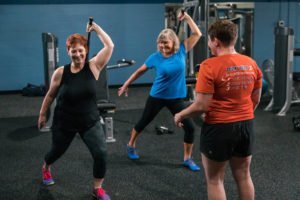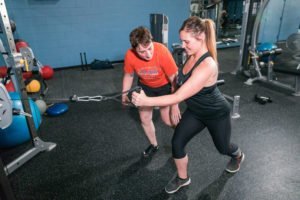By Francesca Wilson, B.A. Exercise Science, ACE Certified Personal Trainer, Precision Nutrition Level 1 Coach
At 3Click Fitness “functional” is probably one of our FAVORITE words! One reason is because “dysfunctional” is one of our least favorite words. As trainers we spend all day looking at different movement dysfunction as we help our clients deal with pain, weakness and tightness that all stem from muscular imbalances. One of my clients pointed out to me that if I want to tell her “No” we shouldn’t do a certain exercise or use a certain machine that she asks about, I always say instead “Well… it’s not very functional”. This is because I want to make the most of my client’s time in the gym by doing movement patterns that mimic everyday life movements. ‘You practice how you perform’ is very true, not just in sport, but everyday. If we are only practicing movement in the gym that is completely unlike movement in life I think we are setting ourselves up for injury at home or work.
Functional seems like the latest and greatest buzzword in fitness marketing. Gyms, fitness companies and even training methodologies have been using it in their branding and names more often over the last few years. However, functional training is not some shiny newly discovered technique. Any personal trainer worth their salt should be using functional resistance movements for most of their programming for most of their clients.
So what does your trainer even mean by this word? There is no official fancy fitness meaning to “functional” but there are a few keys that we are thinking about when we call a resistance exercise functional (or not). In general we are thinking that the movement is overall practical and useful for your daily physicality outside the gym. Hopefully I can help take away some ambiguity for you with my thoughts on what trainers consider when designing programming around functionality:
- Multiple Joints Move – If you are doing an exercise like a squat where 3 or more joints (ankles, knees and hips) are working in conjunction you have a good bet that the exercise is very functional. Something like a leg extension machine where only your knee joint is moving would be a much less functional leg exercise.
- Not Sitting – Just think. When is your real life are you sitting down and moving something around that is over 10 pounds? I personally can’t think of anything in my everyday life… maybe cuddling with my cat. Yard work and housework often require me to be on my feet moving in weird directions (vacuuming and mowing the lawn come to mind) or down on one knee (picking up an object that fell) or even on hands and knees (scrubbing a spill). So you can see that seated resistance exercise when most of your physical work in life is not sitting might not be the most functional.
- Reminiscent of Activity – The movement resembles your favorite active hobby or other daily activity. If you golf you should be doing some rotational movement like a cable woodchop, if you have little kids you should be getting up and down off the ground like in a Turkish get-up or if you love skiing you should be working on adding an unstable surface underneath you. Of course physical hobbies and sports are easy examples but is there a certain type of manual labor that is totally exhausting for you? Tell your trainer about it! They will be able to add some functional exercises that make that activity a bit easier. I focus on my grip and shoulder endurance in the spring because of my heavy weed whacker!
- Feel in the Core – If you can feel your midsection flexing, firing or working hard during an exercise that is awesome! Not only are you creating a strong base of support to move loads with your other limbs, you are engaging the muscles that are most helpful in preventing common injuries. If you feel your lower back muscles, the sides of your trunk or the front of your abdomen working hard that is an indication you are having a great functional workout since that core is firing.
- Out of Breath – If you are working out in a functional way you are likely using way more of your body’s skeletal muscle at once. This means you need to get more oxygen to your muscles for aerobic metabolism (how our muscles get energy to move). Your heart rate will be up and you should be moderately out of breath. Let’s be honest, most of us are in the gym to lose a few pounds and be healthier, not to win a strength competition, so being out of breath is fantastic because it means you are burning more calories.
- Your Goals – At 3Click Fitness your goals are our trainer’s number one priority. If an exercise is helping you get to what YOU WANT then in my mind, it is functional for you. A bicep curl gets made fun of all the time for being ‘not functional’. It doesn’t meet any of the criteria I set forth above. You are only moving 1 joint (elbow), you are likely sitting, there are not many real life movements that it is similar to, you likely not feeling anything the midsection engaging (unless you are consciously bracing) and you are not very out of breath because the bicep is a relatively small muscle. However, if it is important for you to work towards having big and strong looking arms you might enjoy the pump a bicep curl gives you. This move specifically is now functional for you and your big arm goals.
I want everyone’s workouts to be time efficient and great at injury prevention. You go to the gym so you can do your life better, I know the gym itself isn’t your life! Those are the reasons I use mostly functional resistance exercises to help clients achieve goals. Just keep in mind that in the fitness world products and memberships are often what is being sold, not results. The word “functional” is a great way to describe certain resistance movements but if your programming is not designed specifically for you and your goals then is it really that functional at all?
If you want more in depth information on this topic talk to our rockstar functional exercise training authority: Amy Divine!




